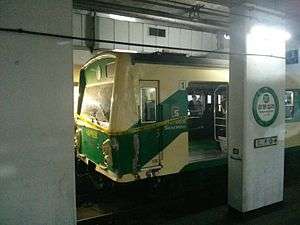2014 Seoul subway crash
The 2014 Seoul subway crash, or the Sangwangsimni station rear-end accident (Korean: 상왕십리역 추돌 사고; Hanja: 上往十里驛追突事故), occurred on May 2, 2014 KST, when two subway cars collided in Seoul, South Korea, injuring 238 people.[3][4][5] The two trainsets that were involved in the accident have since been withdrawn from service.
| 2014 Seoul subway crash | |
|---|---|
 | |
| Details | |
| Location | Sangwangsimni Station, Seoul Subway Line 2 |
| Country | Republic of Korea |
| Line | Line 2 |
| Incident type | Crash |
| Cause | ATS failure[1][2] |
| Statistics | |
| Trains | Rapid transit |
| Injured | 238[3] |
Crash
At 03:30 pm KST (06:30 GMT) of May 2, 2014, a subway train in Seoul crashed into another one on Line 2[3] at Sangwangsimni Station, injuring 238 people with 'no one appearing to be seriously hurt',[4] and about 150 of them suffering bruises and other minor injuries were sent to the nearby hospitals and even the Hanyang University Medical Center.[3][6][7] This was confirmed by Fire officer Kim Kyung-su who said only two people suffered fractures and serious bruises.[7]
According to witnesses, one train was hit from the rear by another incoming train while leaving Sangwangsimni station in the east of Seoul.[4] Another witness said many passengers forced the doors open and escaped onto the tracks after ignoring the onboard announcement which told them to stay inside the cars.[8] The decision by many passengers to ignore instructions was likely due to distrust in authorities after the Sinking of MV Sewol and Daegu subway fire, where instructions to remain onboard resulted in several fatalities.[9]
YTN television reported one subway car was derailed, so passengers had to walk a short distance along the tracks to the station. A government emergency official said that many passengers were injured as they jumped from the subway cars onto the tracks.[4] Yonhap said the train stopped due to mechanical problems after the second train ran into the back of it.[8] It also said that 'a failure in the moving train's automatic distance control system' may have been the cause, while officials were still investigating the accident.[6]
Causes and investigations
The CEO of Seoul Metro later revealed that a faulty Automatic Train Stop signaling system was responsible for the incident.[2] The signaling fault was discovered 14 hours before but remained unfixed at the time of collision.[1] Seoul Metro official Jeong Su-young said that the driver of the moving train applied the emergency brake after noticing a stop signal, but the train could not stop in time.[7] Local news reports revealed 'providing instructions to passengers about what to do' were largely delayed.[7]
See also
| Wikimedia Commons has media related to Sangwangsimni station collision accident. |
- Seoul Metropolitan Subway
- Seoul Subway Line 2
- Sangwangsimni Station
References
- Kim, EJ (6 May 2014). "Police raid Seoul Metro again over train collision". Yonghap News Agency. Retrieved 22 November 2015.
- "South Korean subway collision caused by faulty 'go' signal". DW. 2 May 2015. Retrieved 22 November 2015.
- "Over 200 injured as two trains collide in Seoul subway". RT. May 2, 2014. Archived from the original on July 15, 2014. Retrieved May 3, 2014.
- Kim, Jack; Yang, Kahyun (May 2, 2014). "Subway trains crash in South Korean capital, 200 people hurt". Reuters. Archived from the original on July 13, 2014. Retrieved May 2, 2014.
- Kim Hjelmgaard (May 2, 2014). "Reports: Dozens injured in Seoul subway crash". USA Today. Retrieved May 2, 2014.
- "Seoul subway trains crash, causing minor injuries". The Washington Post. Associated Press. May 2, 2014. Retrieved May 2, 2014.
- Kim, Hyung-jin (May 2, 2014). "Seoul Subway Trains Crash, Scores Injured Lightly". ABC News. Associated Press. Archived from the original on May 7, 2014. Retrieved May 2, 2014.
- "South Korea subway crash injures dozens in Seoul". BBC News. May 2, 2014. Archived from the original on May 5, 2014. Retrieved May 2, 2014.
- Song, Jung-a (2 May 2014). "Dozens injured in Seoul subway crash". Financial Times. Retrieved 22 November 2015.